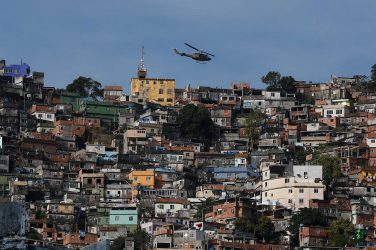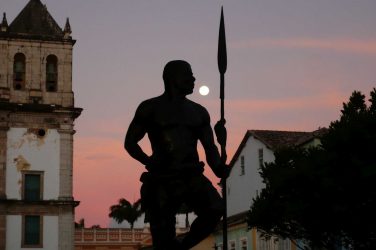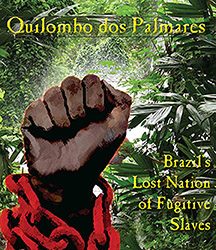Brazilian Blacks have been active in their fight for human rights and
economic justice. The recent celebrations of the tercentenary of the death of Zumbi
the runaway slaves king from the 17th Century has shown the degree of
their commitment to this struggle. In contrast, Mexican blacks are practically invisible.
When one looks at the populations of Mexico and Brazil, some differences stand out. For one thing, the
percentages of persons described as “Negro” or “mulatto” are higher in Brazil than in Mexico. On the other hand, when compared
to the United States, Brazil and Mexico share some of the same features: ambiguity and flexibility in racial
labeling, multiplicity of categories, the tendency of being selectively inaccurate in listing one’s “race”, more acceptance
of intermediate racial categories between “white” and “black”.
Yet, as indicated in Brazil by the celebrations of the death of Zumbi and recent agitation for “black” rights,
problems of persons of African descent have assumed a more center stage than in Mexico. Certainly, that focus is nowhere near
that of the US, where “black/white” conflict is a daily fact of life; however one gets the impression of very little
African/non-African conflict in Mexico.
Both Brazil and Mexico have a legacy of slavery, but there has long been a popular impression that Mexicans
are descendants of Spaniards and Indians only. Even college texts on race relations illustrate this kind of thinking. In
fact, barring a specific agenda to focus on the African Diaspora, attention placed on Africans in Mexico is minimal across
the board. I used a certain library software package which listed 188 recent articles written on Mexico and found no
articles which had Africans as a theme.
Differences in Brazil and Mexico are more demographic and economic rather than philosophic. First,
although intermediate racial categories and miscegenation were accepted both in Mexico and in Brazil, there were more
Africans brought to Brazil than to Mexico (therefore a greater number to be absorbed into the population). Second, the
Indian population of Mexico was more numerous, centrally located and culturally dominant than in Brazil.
Thus, instead of the Brazilian case of African/Portuguese mixtures with an admixture of Indian, the Mexican
example was one of both Spaniards and Africans being absorbed into a vast Indian population. Third, slavery in Brazil was
both longer and more economically important in Brazil than in Mexico, creating more and deeper emotions of
master/slave, exploiter/exploited in Brazil. Fourth, although Mexican culture has elements of racism, the concept of
mestizaje (the idea of the goodness of being classed as racially mixed) is more deeply rooted in Mexico than in Brazil, where the
population is increasingly collectively desirous of the “white” label (a term which is both exclusionary and by nature pointed
toward an ideal of being light rather than brown).
The apparent focus away from the African presence in Mexico starts with the reality of actual racial and
ethnic percentages in Mexico’s population. Figures from the 1990s indicate that only 0.10% of Mexico’s population is Black
or Negro. In 1950, only 0.4% of Mexico’s population was classified as
Afro-mestizo. A look at this data would lead one
to the supposition that “Africans in Mexico” was and is a novelty at most, especially when compared to the
overwhelming Indian and (Spanish/Indian) Mestizo catas mestizo populations grew rapidly. Since the Spanish seldom made an
absolutely clear, analytical distinction between race and culture and never prohibited interracial marriage, miscegenation
never encountered the obstacles it did in the North American colonies.
Fluidity, Flexibility and Ambiguity
Miscegenation is of little consequence, however, unless the society has provisions which allow for its
social significance. By way of comparison, the North American colonies (as well as the United States) were the scene
for miscegenation among Africans, Indians and Europeans. Because of the “hypodescent” rule, however,
miscegenation between Africans and other groups has had little social consequence because, among North Americans, any
African ancestry constitutes membership in the “Negro” or “Black” group.
By distilling combinations which include African ancestry into one socially relevant category (Negro, later black,
later African-American), North Americans have nullified any social effect of miscegenation including Africans. Those
North Americans who claim that the US is a melting pot are essentially correct except the pot is not meant to include
persons of African origin.
On the other hand, the Ibero-American racial classification experience has been, for the past 500 years, an exercise
in ambiguity, subjectivity, flexibility and, in many cases, outright lying. The incredible number of racial and
color designations in Ibero-America boggle the mind. Starting with Hernán Cortés and his mestizo offspring, the
Spanish seemed to have accepted the idea of intermediate racial groups something foreign to the North American mind.
This preoccupation with intermediate racial terms was soon reflected in New Spain’s population and, unlike the case
of Anglo-America, intermediate racial terms included persons of African origin. Eventually, by 1570,
demographic calculations became more complex. An anonymous colonial painting entitled
Las Castas reflects this plethora of racial terms. Of the 16
different racial categories depicted in the painting, 13 portray
persons with African ancestry.
The use of intermediate racial terms had several effects. One was that there became no solid enemy color group
against which Africans (or anyone else) could fight. Individuals with dark skin were occasionally able to advance due to
some (usually military) heroics.
There were always lighter-skinned never-do-wells around and the really rich people were removed from
almost everyone (of any color) anyway. The second effect was an acceleration of the tendency of Africans to take on the
culture
of those with whom they came into contact.
For those Africans who mated with Indians and
produced zamboes, this sometimes meant that they remained in
their Indian communities. For those who identified with Spaniards or who were in the towns, they soon took on
Iberian characteristics and absorbed much of the Indian/Spanish cultural mix which (due to the large numbers of Indians) was
a fact of life.
A third result of the complexity of racial nomenclatures was an ambiguity and unwieldiness which militated
against being able to instantly react to one uniformly on the basis of race. It is relatively easy for a person to develop a
social etiquette for dealing with two, three or even four racial categories, but it is ludicrous to expect him, during his
day-to-day existence, to create appropriate patterns of action for each of 16 or 32 different categories.
Moreover, as anyone familiar with families
supposedly of the same race knows, different siblings can have
different complexions and hair textures. In the multi-layered
classifications eventually created in New Spain, genetic reliability by
appearance became a suspect proposition at best.
Subjectivity in Racial Labeling
In addition to racial classification becoming complex, it also became elastic and subjective. For example,
Aguirre Beltran noted that, by 1570, the Spanish authorities developed the practice of calling legitimate sons of
Indian/Spanish unions Spanish and calling illegitimate sons of Indian/Spanish unions mestizo. Given the fact that, of all the
castas in New Spain, the African, or slave
casta was the lowest, people began the habit of shading racial evaluations so as to
minimize African ancestry. This is why, given that laxity in identifying with Africa, it is astonishing that, in both 1570 and
1810 population estimates by Aguirre Beltran, the Afro-mestizo population was nearly as great as the Indo-mestizo population.
Leslie Rout is graphic in his assessment of the racism present in New Spain, but ironically this very racism served
to skew racial classifications away from those including African ancestry and into those which highlighted Indian
ancestry. African ancestry became gradually absorbed into a broad group of brown-skinned and olive-skinned persons.
In Brazil, the contradictions
Presently, Brazil and the US surpass Mexico in terms of economic prowess and overall potential. However
ironically Mexico has provided an example of a country with importation of African slaves, but little problem between
persons of African descent and others. The Mexicans did this not with the US-style social mechanisms of “civil rights”
movements and legislation designed to force people to behave equitably but rather with miscegenation, multiplicity of
racial categories and an ability to absorb Africans into the population with comparatively little difficulty. In other words,
the Mexicans “out-Brazilianized” the Brazilians. Presently, it is an open question as to whether Brazil will move more
toward the model of Mexico, toward the US model or remain the way it is today: a bundle of contradictions.
READ MORE ABOUT IT
Aguirre Beltran, Gonzalo. La Poblacion Negra de Mexico,
1519-1810. D.F. Mexico: Ediciones Fuente Cultural, 1946, 1972.
El Proceso de Acculturacion. D.F. Mexico: Fondo de Cultura Economica, 1992.
Basave Benitez, Agustin. Mexico Mestizo. D.F. Mexico: Fondo Cultura Economica, 1992.
Carroll, Patrick James. Blacks in Colonial
Veracruz. Austin: University of Texas Press, 1991.
Conniff, Michael and Davis, Thomas J. Africans in the
Americas. New York: St. Martin’s Press, 1994.
Curtin, Philip D. The Atlantic Slave Trade: a
Census. Madison: University of Wisconsin Press, 1969.
Esteva-Fabregat, Claudio. Mestizaje in
Ibero-America. translated by John Wheat. Tucson: University of Arizona Press, 1995.
Fontaine, Pierre Michel. Race, Class and Power in
Brazil. Los Angeles: UCLA Press, 1982.
Freyre, Gilberto. The Masters and the
Slaves. New York: Alfred A.
Knopf, 1946.
Harris, Marvin. Patterns of Race in the
Americas. New York: Walker and Company, 1964.
Klein, Herbert S. African Slavery in Latin America and the
Caribbean. New York: Oxford University Press, 1986.
Knight, Franklin. The African Dimension in Latin
American Societies. New York: Macmillan, 1974.
Morner, Magnus. Race Mixture in the History of Latin
America. Boston: Little Brown, 1967.
Palmer, Colin. Slaves of the White God: Blacks in Mexico,
1570–1650. Cambridge: Harvard University Press, 1976.
Rout, Leslie. The African Experience in Spanish America, 1502 to the Present
Day. London: Cambridge University Press, 1976.
van den Berghe, Pierre. Race and Racism. New York: John Wiley and Sons, 1967.











